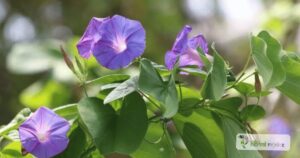Introduction:
Pharbitis seeds, scientifically known as Ipomoea nil (Linn.) Roth, are a primarily used for their purgative and blood purifying actions. Pharbitis seeds has exhibited hypoglycemic activity, making it a potential natural remedy for diabetes.
Pharbitis seeds, also known as Antah-kotarpushpi, Kaalaanjani, Krishnabija, Kaalaadaanaa, Shyaamabija, Shankhani, and Jhaaramaaricha, belong to the Convolvulaceae family.
Habitat and Uses Of Pharbitis Seeds
Pharbitis seeds are abundantly found throughout India and are often considered as a weed. These seeds have a wide range of applications in traditional medicine. The English name Pharbitis seeds is derived from the scientific name Ipomoea nil.
In Ayurveda, they are primarily used for their purgative and blood purifying actions. In Unani medicine, these seeds are known as Kaalaadaanaa, and in Siddha/Tamil medicine, they are called Kaakkattan.
Medicinal Actions of Pharbitis Seeds
The primary medicinal actions of Pharbitis seeds include their purgative and blood purifying properties. They are often used as a substitute for Jalap, another natural purgative.
Studies have shown that these seeds have antifungal properties. In Pakistan, Pharbitis seeds have been found to contain alkaloids such as lysergol, chanoclavine, penniclavine, isopenniclavine, and elymoclavine.
They also contain approximately 14.2% resin and glucosides. Commercial samples of the seeds typically contain around 14-15% of crude resinous matter.

Research Findings
Recent research has shown that the glycosidal part of the resin found in Pharbitis seeds is inert. However, the nonglycosidal resin, which comprises 2% of the seeds, has been found to cause copious purgation in doses of 250 mg.
In addition to the resinous matter, these seeds also contain a fixed oil (12.4%) and small amounts of saponin, mucilage, and tannin.
Pharbitis seeds also possess anthocyanin pigments in their flowers. Furthermore, plant extract from Pharbitis seeds has exhibited hypoglycemic activity in rats, making it a potential natural remedy for diabetes management.
Dosage and Usage of Pharbitis Seeds
Pharbitis seeds are typically consumed in powdered form. The recommended dosage is 3-6 grams of powder. However, it is advisable to consult with a qualified Ayurvedic practitioner or healthcare professional before starting any new herbal remedy.
Conclusion:
Pharbitis seeds, also known by their scientific name Ipomoea nil, have been used for centuries in traditional medicine for their purgative and blood purifying properties.
These seeds are rich in resin, alkaloids, and other bioactive compounds that contribute to their medicinal actions. With careful and responsible usage, Pharbitis seeds can be a valuable addition to natural healthcare routines.
However, it is always recommended to seek guidance from a healthcare professional before incorporating any new herbal remedy into your routine.
Frequently Asked Questions(FAQs)
What are Pharbitis seeds?
Pharbitis seeds, scientifically known as Ipomoea nil (Linn.) Roth, are popular natural remedies in Ayurvedic medicine.
What are the traditional uses of Pharbitis seeds?
Pharbitis seeds have traditionally been used for their purgative and blood purifying properties.
What family do Pharbitis seeds belong to?
Pharbitis seeds belong to the Convolvulaceae family.
Where are Pharbitis seeds found?
Pharbitis seeds are abundantly found throughout India and are often considered as a weed.
What is the English name for Pharbitis seeds?
The English name for Pharbitis seeds is derived from their scientific name, Ipomoea nil.
What are the primary medicinal actions of Pharbitis seeds?
The primary medicinal actions of Pharbitis seeds include their purgative and blood purifying properties.
What are the other names for Pharbitis seeds in Ayurveda?
Pharbitis seeds are known as Antah-kotarpushpi, Kaalaanjani, Krishnabija, Kaalaadaanaa, Shyaamabija, Shankhani, and Jhaaramaaricha in Ayurveda.
What are the other names for Pharbitis seeds in Unani medicine?
In Unani medicine, Pharbitis seeds are known as Kaalaadaanaa.
What are the other names for Pharbitis seeds in Siddha/Tamil medicine?
In Siddha/Tamil medicine, Pharbitis seeds are called Kaakkattan.
What are the active compounds found in Pharbitis seeds?
Pharbitis seeds have been found to contain alkaloids such as lysergol, chanoclavine, penniclavine, isopenniclavine, and elymoclavine.
Do Pharbitis seeds have antifungal properties?
Yes, studies have shown that Pharbitis seeds have antifungal properties.
How much resin do Pharbitis seeds typically contain?
Commercial samples of Pharbitis seeds typically contain around 14-15% of crude resinous matter.
Are Pharbitis seeds safe to consume?
Pharbitis seeds can be consumed safely when taken in the recommended dosage.
How should Pharbitis seeds be consumed?
Pharbitis seeds are typically consumed in powdered form.
What is the recommended dosage of Pharbitis seed powder?
The recommended dosage of Pharbitis seed powder is 3-6 grams.
Can Pharbitis seeds be used as a natural remedy for diabetes management?
Plant extract from Pharbitis seeds has exhibited hypoglycemic activity in rats, indicating its potential as a natural remedy for diabetes management.
Can anyone consume Pharbitis seeds?
It is advisable to consult with a qualified Ayurvedic practitioner before starting any new herbal remedy, including Pharbitis seeds.
Can Pharbitis seeds be used as a substitute for Jalap?
Yes, Pharbitis seeds are often used as a substitute for Jalap, another natural purgative.
What is the inert part of the resin found in Pharbitis seeds?
Recent research has shown that the glycosidal part of the resin found in Pharbitis seeds is inert.
What other bioactive compounds are found in Pharbitis seeds?
Pharbitis seeds also contain a fixed oil, small amounts of saponin, mucilage, and tannin, in addition to their resin and alkaloids.


